And God Created Woman, 1956, directed by Roger Vadim, screenplay by Roger Vadim and Raoul Lévy.
After 76 Criterion films, we finally arrive at straight exploitation. And God Created Woman has a joke of a plot, terrible acting, retrograde sexual politics, and exactly three good qualities: eye-popping colors, CinemaScope, and Brigitte Bardot. And the first two aren't that important. And God Created Woman is more colorful (and racist) than Black Orpheus, fluffier than Charade, more voyeuristic than Peeping Tom. You know pretty much what you're in for from the film's fifth shot:
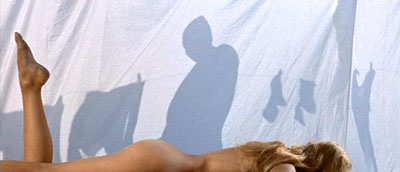
Like I said, bright colors, Cinemascope and Brigitte Bardot. It's not too hard to figure out why this film caused a sensation in 1956. Of course, leering at Brigitte Bardot wouldn't be acceptable without some semblance of a plot. And that's exactly what Vadim and Lévy provide: some semblance of a plot. Bardot plays an orphan named Juliette who's living in foster care in St. Tropez. That silhouette on the other side of the sheet is a yachtsman and real estate developer named Eric Carradine, played by future Bond villain Curd Jürgens:

Like anyone with a Y chromosome, Mr. Carradine has unwholesome plans for Juliette. Unfortunately for him, she only has eyes for a local cad named Antoine Tardieu, played by Christian Marquand:
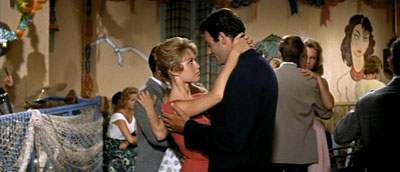
Tardieu is willing and eager to sleep with her, but wants nothing else to do with her. As the movie opens, Juliette's relationship with her foster parents has deteriorated to the point that she is using her foster father in his wheelchair as a shield to keep her foster mother away:
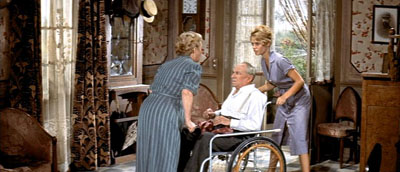
Like Helena in Autumn Sonata, this is the sort of filmic use of the handicapped that you are unlikely to ever see again on screen. Anyway, to prevent further wheelchair battles, Juliette's foster mother arranges to have her sent back to the orphanage. To avoid this fate, she marries Antoine's younger brother Michel, out of an unconvincing mixture of spite and desperation. Jean-Louis Trintignant plays Michel as a brooding, sensitive type with low self-esteem:
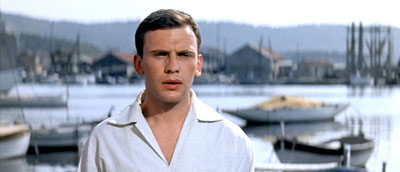
You can see where this is going: Juliette's sexuality is too wild and uncontrollable to ever be tamed by such a man as Michel; neither Antoine nor Carradine can resist her, scandal ensues, and so on. Along the way, Vadim puts Bardot in as many shots as possible, whether she's sullenly eating a carrot:
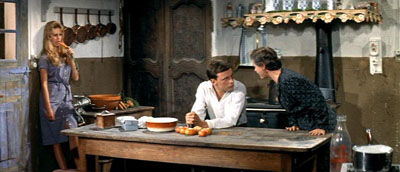
Or sullenly opening an umbrella indoors for some reason:

Or even not-so-sullenly putting on a dressing gown behind the most unlikely-to-actually-be-sitting-there ship model with a semi-translucent curtain in cinema history:

This isn't a narrative film so much as it's a peepshow, but as peepshows go, it's first-rate—if you're from the fifties and incredibly repressed. Still, the film does have its charms. San Tropez looks suitably picturesque:
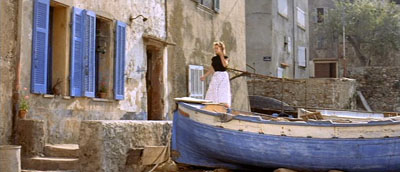
The cinematography isn't brilliant, but there are some nice CinemaScope compositions (although virtually no closeups):
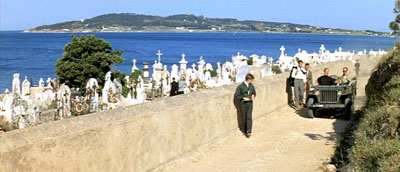
And although this was shot in Eastmancolor, a single-strip film that I thought was responsible for the faded look of many post-three-strip-Technicolor movies, it's very crisp and bright.
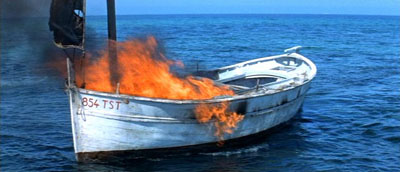
In San Tropez, even color is more saturated. None of that outweighs the terribleness of a film that takes it as a given that Bardot alone is responsible for corrupting the men around her. When Antoine sleeps with his little brother's wife, then walks off to tell his mother that they have to throw Juliette out of the house, there's hardly a suggestion that Antoine shares any of the blame.
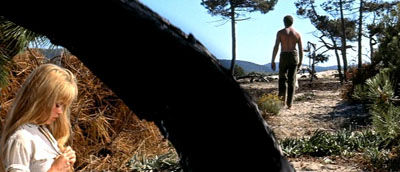
And I'm not even going to comment on Juliette's final descent into alcohol-fueled madness, where she falls so far that she dances with black men:
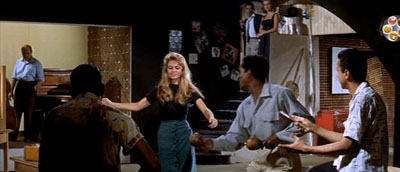
Let's just say that the film leaves a lot to be desired, politically and sexually. Its principal value today is, as Nathan Rabin wrote for The Onion A.V. Club, "a historic bit of pop-culture sociology." As historic bits of pop-culture sociology go, this one's painless and easy to look at. Just don't expect a great film.
Randoms:
- Roger Vadim was married to Bardot at the time they made this film (he'd been dating her since she was 15 and he was 21, if his IMDB page is to be believed). I'm not sure if that makes it more or less creepy that he made a film whose principal attraction was staring at Brigitte Bardot, but I think it makes it more of an exploitation picture. This was Vadim's MO for the rest of his life: he dated Catherine Deneuve while directing her in Le Vice et La Vertu, and he was married to Jane Fonda when he directed her in Barbarella. I suspect Robert Rodriguez has studied Vadim's career closely. But given the relative fame and success of Vadim compared to Bardot, Deneuve, and Fonda, I think Rose McGowan may have paid more attention.
- About that film Le Vice et La Vertu: I haven't seen it, and hadn't heard of it until this evening. But it's an adaptation of the Marquis de Sade's Justine set during World War II, with Nazis. Which reminds me a bit of the hardest-to-watch-film in the Criterion Collection, made twelve years later.
- As attractive as Bardot is, there are at least two other bodies at least as curvy and attractive. Carradine's yacht:
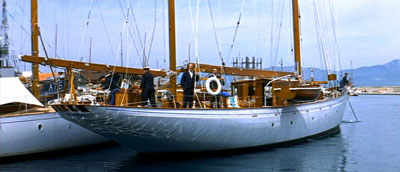
- And his car, a Lancia Aurelia B24 Spider.
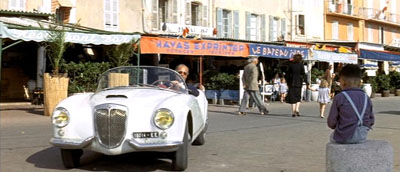
- Putting Bardot and the car in the same frame seems gluttonous, but here you are:

- A confession: a disproportionate amount of this site's traffic comes from people doing image searches for various actors and actresses (that, and middle school students looking for essays to steal about The Most Dangerous Game or Lord of the Flies). So, with a tip of the hat to Roger Vadim, here's one more picture of Brigitte Bardot, one of the film's few closeups. Greetings, internet horndogs!
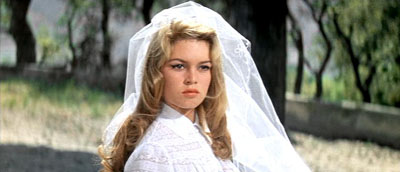


9 comments:
Bardot's glare in that last photo seems oddly appropriate to the leering goons of Internet-land.
That's why I chose it!
Aw, d'oh. What a Capt. Obvious moment.
If I remember correctly the clothesline scene you captioned in the beginning of your collumn was featured in Cinema Paradiso. The film is being shown in the cinema of the title. The camera cuts from viewing the projected image of Bardot naked infront of the white rippling 50 count threads, to pan across the awestruck faces of a front row of little boys jerking off. Hilarious.
I think it's interesting how the last three films (Brief Encounter, Chasing Amy and this one) form a loose trilogy which capture the sexual mores of their times.
I don't think this movie is that judgmental regarding Bardot's character, and it certainly doesn't sympathize with the characters who want to send her back to the orphanage. Instead, Juliette is simply a force of nature that brings out some of the worst and silliest qualities in the men around her. Juliette is just the way she is and Vadim sees no need to apologize or condemn.
This is not a great film, but I took great pleasure in watching it, both for great cinematography and Bardot's sex appeal (could any red-blooded heterosexual male resist using the step function on their player to find out just how much of Bardot was revealed?).
Shawn,
I remember that scene, and remember not recognizing the film they were watching. Next time I'll know what's what. Also--now my blog will show up in google searches for "little boys jerking off," which should bring a lot of new visitors to the site, so thanks!
Mark,
Yeah, you're right—all three are so completely of their time. You should suggest a box set or one of those "shelf" things they have on their website to Criterion.
See, I think reducing Juliette to a "force of nature" is judgemental, because it denies her any agency. But yeah, I enjoyed watching the film for the same reasons you did.
Wonderful entry, Matthew. This film probably marks the closest that our two projects will intersect - fwiw here's what I had to say on the film:
http://alsolikelife.com/shooting/?p=171
and
http://alsolikelife.com/shooting/?p=182
alsolikelife,
I enjoyed your essay and video very much, especially the way you pick apart the final scenes in the video. Nice soundtrack choice at the end, also. Let's make them live links:
Essay and Video. By the way, I'm very impressed with your site & will add it to my blogroll.
Post a Comment